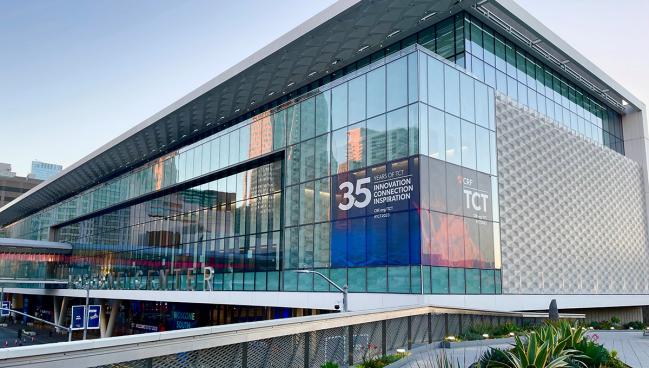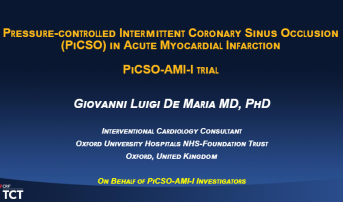Intermittent Coronary Sinus Occlusion Fails to Cut Infarct Size in STEMI
PiCSO as a concept shouldn’t be thrown away, but patient selection must be honed, Giovanni Luigi De Maria says.

Pressure-controlled intermittent coronary sinus occlusion (PiCSO) therapy added to primary PCI does not seem to reduce myocardial infarct size in patients with anterior ST-segment elevation myocardial infarction, according to PiCSO-AMI-I, the first multicenter, prospective randomized trial of this technology.
PiCSO aims to stimulate collateral blood flow to the ischemic region of the myocardium by increasing venous pressure. Earlier studies, including some in surgical coronary bypass more than three decades ago, have suggested that the addition of PiCSO could improve microvascular function and reduce infarct size.
Not being able to confirm this reduction in infarct size in the PiCSO-AMI-I trial “comes with a bit of disappointment,” Giovanni Luigi De Maria, MD, PhD (Oxford University Hospitals NHS-Foundation Trust, England), who presented the PiCSO-AMI-1 data at TCT 2023, told TCTMD. “But of course, we are trying to explore why this could have happened.”
Nonspecific patient selection, loss to follow-up, and suboptimal device placement all likely contributed to the neutral findings observed here, he said.
PiCSO entails inserting an 8-Fr balloon-tipped catheter via transfemoral access using a 10-Fr steerable guide sheath for coronary sinus positioning. Once in place, the balloon is inflated to occlude the coronary sinus for several cardiac cycles according to a proprietary algorithm—with a treatment target time of 45 minutes. It’s done during primary PCI after the occluded vessel is reopened but prior to stent insertion and deployment. As the PiCSO balloon deflates, normal venous drainage from the heart resumes, thus preventing engorgement.
PiCSO Results
For the study, the researchers randomized 145 STEMI patients (median age 61 years; 79.3% male) to primary PCI with (n = 72) or without PiCSO (n = 73) at one of 16 European centers between July 2019 and August 2022. About half of patients had single-vessel disease, with just under one-third having two-vessel and 16.6% having three-vessel disease. TIMI flow was 0 in most (84.8%) patients at baseline, with the remainder classified as TIMI flow 1.
Unsurprisingly, PiCSO-assisted primary PCI was associated with longer procedural (99.5 vs 35.0 minutes) and fluoroscopy times (21.0 vs 10.0 minutes), more radiation (53.6 vs 29.3 Gy*cm2), and a greater use of contrast dye (190 vs 160 mL; P < 0.001 for all). PiCSO procedural success was reported in 86.1% of cases, and 63.9% achieved at least 45 minutes of therapy.
Six-month safety outcomes showed comparable results between PiCSO-assisted and conventional primary PCI. There were no differences with regard to MACE (9.7% vs 8.2%), all-cause death (1.4% vs 2.7%), heart failure hospitalization (5.6% vs 2.7%), stroke (0 vs 4.1%), stent thrombosis (0 vs 1.4%), or BARC 3-5 bleeding (2.8% vs 0). No instances of coronary sinus damage were seen in the study group.
For the primary endpoint, infarct size—defined as a percent of the left ventricle at 5 days on cardiac MR—PiCSO-treated patients were no better off than those who did not receive the therapy (27.2% vs 28.3%; P = 0.59). Notably, only 76.4% and 87.4% of the study and control groups, respectively, had this data available for the comparison.
Results were similar in a per-protocol analysis, and several subanalyses by age, sex, diabetes, hypertension, and total ischemic time able showed no difference in infarct size with PiCSO. There were also no differences observed for secondary endpoints including microvascular obstruction, presence, and occurrence, as well as infarct size at 6 months.
Intramyocardial hemorrhage, a possible concern due to the risk of engorgement with venous occlusion in the PiCSO patients, was similar between groups.
Patient Selection, Procedural Questions
Discussing the study during the session, Adnan Kastrati, MD (Deutsches Herzzentrum München, Germany), asked why the researchers did not use the index of microcirculatory resistance (IMR) as an inclusion criterion for the trial like they had with past studies.
De Maria said they decided to use TIMI 0/1 flow for simplicity here, but in the end, it was likely not granular enough to differentiate the patients who could benefit from PiCSO. He added that infarct size at 5 days ranged from 5% to 50%, noting, “There is an argument that if you include . . . patients with small infarct size, it is going to be very difficult to prove an additional value of an extra therapy like this one.”
If another clinical trial is designed for PiCSO, De Maria said he’d recommend using IMR to help with “fine-tuning” the group of patients with evidence of microvascular dysfunction prestenting who would likely benefit from additional therapy.
Kastrati also questioned the ideal timing of PiCSO, suggesting that doing it before blood flow was restored might lead to “better results.”
In response, De Maria said that all signs point to this therapy working best when it’s deployed as early as possible, but that means delaying primary PCI, which puts “extra pressure” on the operator and the cath lab team. The ongoing STEMI-DTU trial looking at using the Impella device (Abiomed) before primary PCI will face similar challenges to this one, De Maria predicted.
Still, he stressed, while this trial was neutral, “the concept of coronary sinus occlusion is not something that we should completely discard.” De Maria pointed to promising studies using a coronary sinus reducer in patients with refractory angina, saying, “It's possible that this technology might still have a [role].”
The Wrong Endpoint?
PiCSO-AMI-I joins a long list of failed trials attempting to reduce infarct size during STEMI. “We keep sort of doing the same thing over and over again and expecting a different result,” commented panelist Roxana Mehran, MD (Icahn School of Medicine at Mount Sinai, New York, NY). “This probably is like the fortieth trial that I have seen with a negative infarct size in the setting of an MI and the assessment with MRI for infarct size. Are we just completely lost with the wrong endpoint here? . . . And have we thrown out a lot of therapies because the endpoint has been wrong?”
De Maria agreed study design is worth revisiting, but asserted that PiCSO-AMI-I’s endpoint, especially the 5-day cutoff for infarct size, is in line with consensus guidelines—12 days, for example, would be an impractical length of time to keep patients in hospital. Ideally investigators would identify a surrogate endpoint linked to long-term clinical outcomes that is readily available in the cath lab after reperfusion and doesn’t require additional cardiac imaging, he added.
“Reducing infarct size in STEMI patients remains an unmet clinical challenge,” De Maria concluded. “That means that we still have to invest resources, not just financially but also intellectually, and try to solve this problem that has been there for 30 years and try to have this sorted once and for all.”
Yael L. Maxwell is Senior Medical Journalist for TCTMD and Section Editor of TCTMD's Fellows Forum. She served as the inaugural…
Read Full BioSources
De Maria GL. Pressure-controlled intermittent coronary sinus occlusion (PiCSO) in acute myocardial infarction: PICSO-AMI-I trial. Presented at: TCT 2023. October 25, 2023. San Francisco, CA.
Disclosures
- The study was sponsored by Miracor Medical.
- De Maria reports receiving grant/research support from Abbott, Medtronic, Terumo, Philips, Opsens, and Miracor Medical and consultant fees/honoraria from Miracor Medical SA and CorFlow.





Comments